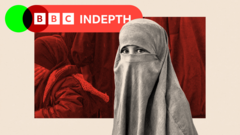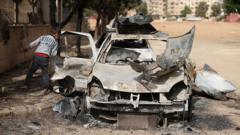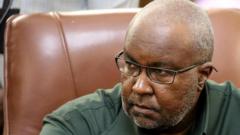The recent fall of Bashar al-Assad has ushered in a wave of celebrations and social freedoms in Syria, yet the political landscape remains fragile. As citizens enjoy opportunities for open dialogue and cultural expression, questions loom regarding the commitment to democracy and the risk of rising conservatism, prompting concerns over the future of women's rights, religious freedom, and political accountability.
Navigating New Freedoms: Syria's Uncertain Future Post-Assad

Navigating New Freedoms: Syria's Uncertain Future Post-Assad
As Syria emerges from over four decades of authoritarian rule, citizens embrace newfound freedoms while grappling with concerns over their longevity and potential shifts towards a more conservative regime.
On December 8, 2024, a significant shift occurred in Syria as Bashar al-Assad's 24-year-long regime collapsed, leaving citizens eager for change. While many embraced the freedom to speak openly and openly discuss politics—something unimaginable during Assad's rule—there are growing fears about the sustainability of these newfound liberties.
The fall of the Assad regime catalyzed celebrations across major cities, from Damascus to Aleppo, where many rejoiced in the newfound ability to express themselves without fear. Women and men alike celebrated together in public forums and cafés, which had previously been focal points for regime repression. Syrian journalist Mohammad Ghannam returned home after years in exile, filled with hope that the nation could finally rebuild—reflected in the vibrant cultural scene that has re-emerged since November 2024.
Despite this positive shift, apprehensions about future governance are rising. The new interim president, Ahmed al-Sharaa, previously affiliated with the Islamist group Hayat Tahrir al-Sham, is under scrutiny for his commitment to establishing a lasting democracy. Critics worry that his administration may prioritize a concentration of power over inclusive governance, reminiscent of the past.
The cultural landscape of Syria has seen a renaissance, with artists feeling freer to express themselves. Yet, there is wariness about possible censorship based on religious norms, ushering in a time where conservative interpretations of Islam may impact freedom of expression within the arts. Under Assad, dissenters were silenced; now, however, some fear that the new regime could repress artistic expression in favor of conservative values.
A significant concern also surrounds women's rights. Historically, women in Syria have enjoyed substantial freedoms compared to many other Middle Eastern countries. However, some advocate for a stricter interpretation of Islamic law, raising alarms about potential restrictions on women's participation in public life, which would be a drastic regression from past rights. There are no official decrees establishing new limitations, but societal pressures and changes in the legal landscape could begin to influence the status of women in Syria.
Amidst these challenges lies a vital question about the political future of the nation. Recent attempts at national dialogue have been criticized for lacking inclusivity and failing to represent the diverse voices of the population. While the interim government has made some appointments indicating a willingness to embrace shared governance—like adding a Christian minister—the overarching sentiment remains one of caution. The fear of returning to a system of authoritarianism looms large, as past betrayals have left many Syrians skeptical of political promises.
As Syria treads this precarious path, the intertwining issues of power, representation, and cultural integrity will define its evolution. With democracy still an aspiration rather than a reality, the risks of disillusionment among the populace could threaten the country's future stability, illustrating the complexities of constructing a resilient state after decades of tyranny.




















